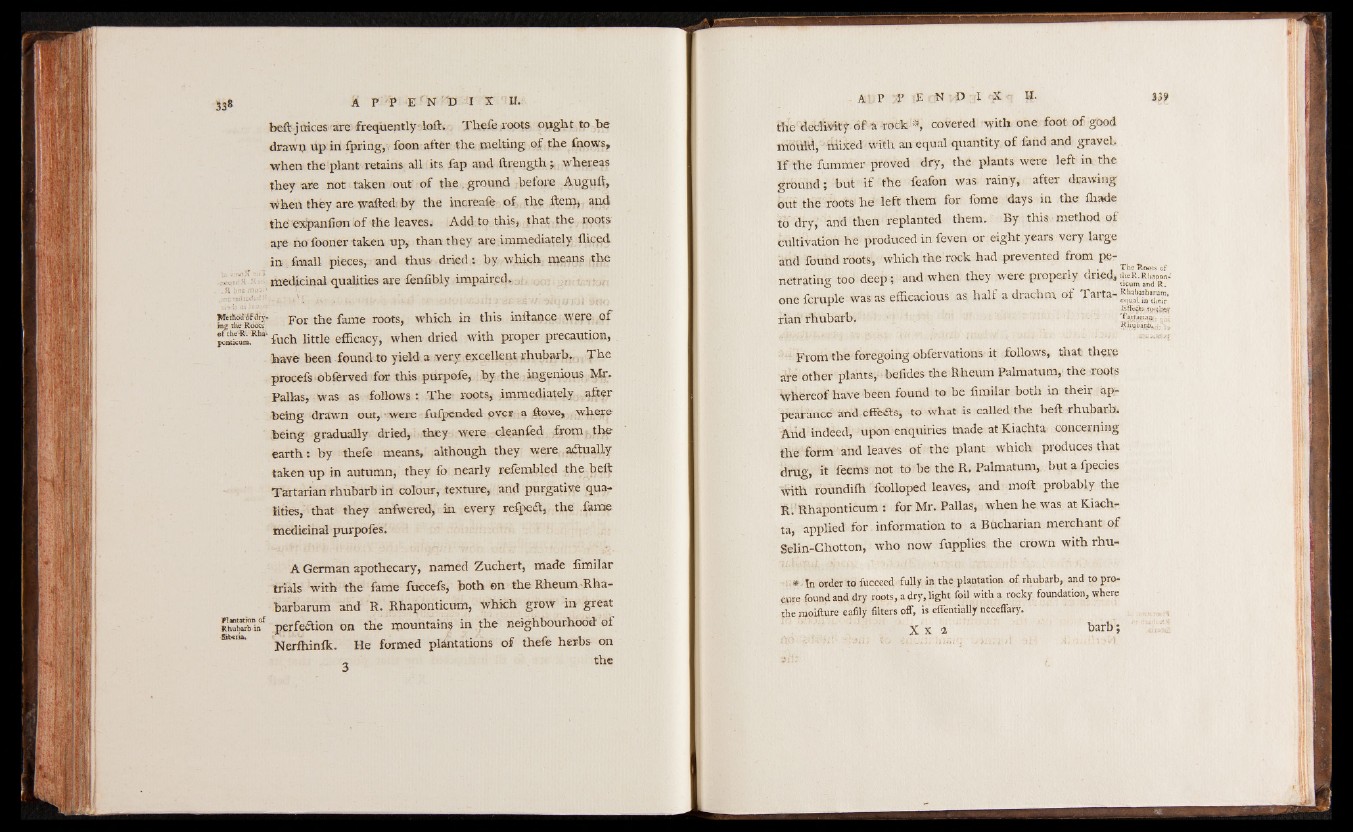
.H b<
Wcthotl 6f drying
the Roots
®f theR. Rha-
ponti-cum.
Plantation of
Rhubarb in
-Siberia*
beft juices are frequently-loft. Thefe roots ought to he
drawn tip in fpring,-. foon after the melting of the fnows,
when the plant retains all its fap and ftrength; whereas
they are not taken out of the , ground before Auguft,
when they are wafted; by the increafe of. the ftem, and
the expanfton of the leaves. Add to this, that the roots
are ho fooner taken up, than they are immediately diced
in fmall pieces, and thus dried: by which means the
medicinal qualities are fenfibly impaired.
For the fame roots, which in this inftance were of
fuch little efficacy, when dried with proper precaution,
have been found to yield a very excellent rhubarb., The
procefs obferved for this purpofe, by the ; ingenious Mr.
Pallas, was as follows : The roots, immediately , after
being drawn out, - were fufpended over a ftove, where
being gradually dried, they were cleanfed from j tl>e
earth: by thefe means, although they were actually
taken up in autumn, they fb nearly refembled the heft
Tartarian rhubarb in colour, texture, and purgative qualities,
that they anfwered> in every refpedt, the fame
medieinal purpofes.
A German apothecary, named Zuchert, made fimilar
trials with the fame fuccefs, both on the Rheum Rha-
barbarum and R. Rhaponticum, which grow in great
perfection on the mountains in the neighbourhood of
Nerfhinfk. He formed plantations of thefe herbs on
the
the deefetty of a jrock % covered with one foot of good
mould, mixed with an equal quantity of fand and gravel.
I f the fummer proved dry, the plants were left in the
ground; but if the feafon was rainy, after drawing
out the roots'he left them for fbme days iu the {hade
to dry, and then replanted them. By this method of
cultivation he produced in feven or eight years very large
and found roots, which the rock had prevented from pe-
netrating too deep ; and when they were properly uned,
one fcruple was as efficacious as half a drachm of Tarta-^;^-;",
rian rhubarb, Mnsfjp&Pvd si«
From the foregoing obfervations it follows, that there
are other plants, befides the Rheum Palmatum,- the roots
Whfereof have been found to be fimilar both in their appearance
and effects, to what is called the beft rhubarb.
And indeed, upon enquiries made at Kiachta concerning
the form and leaves of the plant which produces that
drug, it feems not to be the R. Palmatum, but a fpecies
with roundifh fcolloped leaves, and moft probably the
R. Rhaponticum : for Mr. Pallas, when he was at Kiachta
applied for information to a Bucharian merchant of
Selin-Chotton, who now fupplies the crown with rhu-
* In order to fucceed fully in the plantation of rhubarb, and to procure
found and dry roots, a dry, light foil with a rocky foundation, where
the moifture eafily filters off, is effentially neceffary.
‘ X x a barb ;